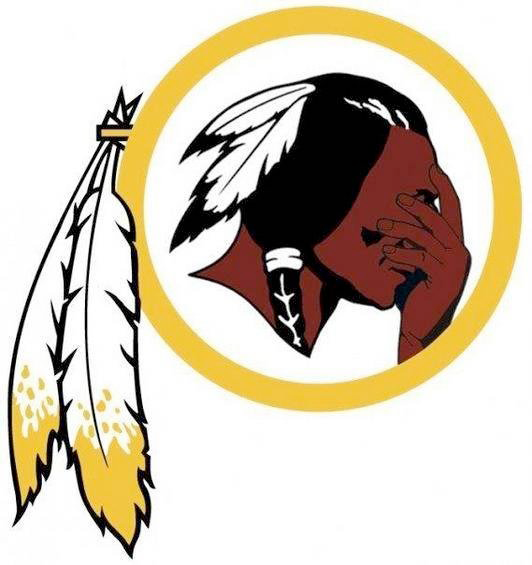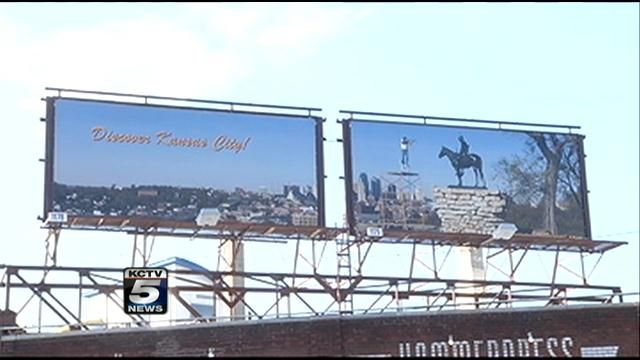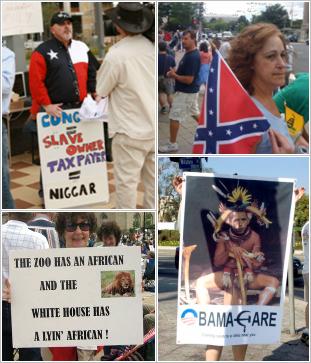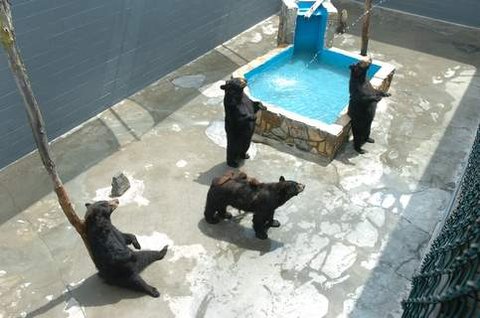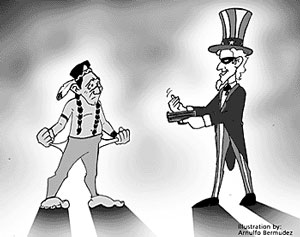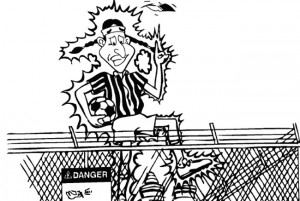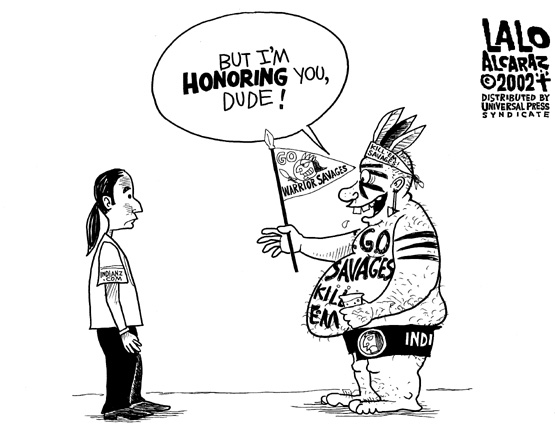Here's a typical conservative column on the "Redskins" controversy:
On the Redskins name controversy
It's noteworthy because of the writer:
Sylvia Thompson is a black conservative writer whose aim is to counter the liberal spin on issues pertaining to race and culture.
Ms. Thompson is a copy editor by trade currently residing in Tennessee.Let the demolition begin
Here are excerpts from her column with my responses:
I read that the Washington Redskins football team owner, Daniel Snyder, is being pressured to change the team's name, because it may be offensive to American Indians.You mean it
is offensive according to the dictionary. The only question is how racists like you justify the offense, not whether the word's meaning is offensive.
Side note: I view every American who was born in this country, who has centuries of history on this soil, as "native American." I am a native American, with over two-hundred years of heritage passed on from my ancestors, who were brought here from Africa. That the term should be applied to only one segment of the American populace is a misuse of that term.No, your ignorance is a misuse of your brain.
Okay, you're a "native American." That uncapitalized phrase applies to any individual born here. The capitalized version, "Native American," is a proper noun that applies to a whole group of people. Including their ancestors. As a group, these people--also known as Indians--are native to the Americas no matter where they were born individually.
Get it? The phrase "native American" is a generic term that's different from "Native American." Similarly, anyone who herds cows can call himself a cowboy, but only a member of the Dallas football team is a Cowboy. Capitalization give the term a specialized meaning.
Duhhh.
If you want to argue that Indians came from somewhere else, okay. Their ancestors came here 20,000 years ago while your ancestors came here 200 years ago. They've lived here literally
a hundred times longer than you have.
True, they may not be natives, technically speaking. So their claim to the land isn't infinitely better than yours; it's "only" a hundred times better. They're
a hundred times more native than you are.
When you acknowledge that, we can think about taking the rest of your column seriously. Until then, your pretense that everyone is equally "native" is stupid beyond belief.
Thompson justifies genocideTo the issue of who claims it, I say that only the group who was strong enough to occupy and hold it can make that claim. Nations are built on that premise.Right makes might...the favorite argument of every conservative thug. Let's "enjoy" Thompson's defense of the Euro-American genocide of Indians.
People without a safe place to thrive have throughout history sought out safe haven in other lands.The English settlers were motivated by religious fanaticism or greed, not a quest for a "safe haven." Same with the Spanish settlers, although they were fanatical about converting heathens, not practicing their own hardcore fundamentalism.
If they found such a place, either they ingratiated themselves to the current occupants, or they mustered the force to take over that land. Whoever was strongest, took possession."Mustered the force" means killing innocent people. So Thompson is okay with mass murder because it's some sort of natural process.
I guess she supported Al Qaeda's attack on 9/11, since that was basically the same thing. The terrorists were trying to exert their strength just like the European colonists did.
Vanquished people then decided whether they would meld with the victors and take advantage of the positives that they afforded (Japan being an example) or they isolated themselves from the victors (American Indians being an example).Indians chose to isolate themselves?! You mean after the Americans took away their ability to roam freely and forcibly corralled them into reservations? That's like blaming a convict for staying in his cell after society falsely imprisoned him for a crime he didn't commit.
That is, if the victors chose not to destroy the vanquished. History is replete with such destruction. America chose not to destroy.Huh? Americans took about 98% of the Indians' land, banished about 98% of their cultures, and killed about 98% of them. So "not to destroy" means "destroyed 98% but not 100%"? Well, gee, thanks for
nothing two percent.
Guess what would happen if you robbed someone of 98% of his possessions and let him keep 2%? You wouldn't be rewarded for your compassion. You'd be jailed for your crimes.
Bleeding hearts can whine and moan over the atrocities that accompany such survival tactics, but those tactics are the way of human existence.Is that what you say to the victims of terrorist attacks, mass shootings and bombings, etc.? Get over it because everyone suffered some massacre in the past? Or are you a goddamned racist who thinks only white Anglo-Saxons can kill whoever they wish?
 Racists should be free?That a term used by the natives themselves would be derogatory does not make any sense, Goddard points out. And he is correct.
Racists should be free?That a term used by the natives themselves would be derogatory does not make any sense, Goddard points out. And he is correct.
That said, the term took on a derogatory nature sometime during the 19th Century, according to the article.Since the second statement obviates the first statement, this whole passage is a waste of space. Go back to the beginning where I said "redskins"
is offensive according to the dictionary. End of story.
History aside, what we are dealing with now is an attempt to dictate to a private owner (Daniel Snyder) how he must handle his private property (a football team)."Attempt to dictate" means we're using the free market of ideas to champion our position, same as Snyder. He can name the team whatever he wants, as long as it doesn't violate the (trademark) law, and we can protest it. If you don't like the concept of protest, you're in the wrong country, idiot.
You gotta love how a black woman uses
white mainstream "privilege" to frame her argument. Snyder is just doing his thing, exercising his property rights, while activists are "trying to dictate" to him.
How about an alternate frame? Snyder is trying to dictate how Americans perceive Indians--as primitive savages aka "redskins." And activists are exercising their First Amendment right to challenge him.
Yes, racists hate it when we "infringe" on their freedom to be racist. Too bad, racists. If you don't like people pointing out your racism,
stop being racist.
Quit bawling like babies because someone's asking you to stop acting like the center of the universe. Grow up and learn to respect other people's feelings.
There will be those who offer, "Suppose somebody named a team Sambos or Uncle Toms?" To that statement, my first response would be that those terms have no history of representing anything but the denigration of black people.I strongly suspect Thompson is wrong here. I'd bet the people who first used the terms "Uncle Tom" and "Sambo" thought they were neutral or even positive. And the terms evolved into recognized slurs only over time--just like "redskins."
Redskins, on the other hand, in its use today, references masculine bravery as represented by fighting native warriors.Huh?! No one applies the word "redskins" to "fighting native warriors" today except ignorant sports fans. That's almost literally the word's only use.
You think any flesh-and-blood Native warriors prefer the term "redskin"? Try calling a roomful of Native soldiers that and see how they react.
Just to be sure, add a few terms of endearment such as "Chief," "Tonto," and "Geronimo." Veterans love to be compared to these symbols of Native masculinity.
Offensive but ignore it?My next response would be that, as a black person, I am not affected by such names. I know who and what I am, and what I am called is irrelevant.This is irrelevant unless you concede the name is derogatory. Which it is according to the dictionary.
So your contradictory arguments are 1) "Redskins" isn't offensive and 2) "Redskins" is offensive but I don't care? Why don't you pick one argument and stick with it, okay?
Why, then, is there an issue? Especially since the few instances of the name (as with the Redskins team) are in reference to manliness and bravery.Actually, Suzan Shown Harjo and others have documented the long history of people using "redskin" as an insult. The sports context is the only one, out of many, where people (wrongly) claim the word isn't offensive.
Somehow, the sports field magically makes "niggers," "kikes," "wetbacks," "chinks," and "redskins" okay. Oops, I meant only "redskins." The offensive terms for other ethnic groups are still taboo.
I have seen no statistical proof that a majority of Indians are offended by that term.We've discussed the polling data at length. The polls are flawed because they don't distinguish between how people feel and what they'd do.
And who says a majority has to be offended before something is wrong? If a solid minority is offended, that's arguably enough to instigate a change.
And it is very clear that the fans of the Redskins are not offended, or they would avoid the games.Who cares what ignorant non-Indian fans think? And who says that fans who attend in person are more important than fans watching on TV or Americans in general?
Since the name affects Indians, including Indian children who can't "ignore" it, they should be the primary judges. Not fans who have a vested interested in retaining an ethnic slur and telling themselves they're not racists.
This situation brings to mind an interview that I saw on television many years ago with Maria Tallchief, the great American ballerina. The commentator asked her if she minded being called "Indian," to which she replied, no.Except "Indian" isn't a slur, though a few misguided liberals think it is. In contrast, most dictionaries label "redskins" a slur.
So "not a slur" vs. "a slur." Great anecdote except for comparing something with its opposite. In other words, not a great anecdote.
To whatever degree you are offended by the name Redskins, the offense is not worth the effort.Again, Thompson tacitly admits the offense. In other words, she tacitly acknowledges her own "masculine bravery" argument is rubbish. No need to thank me for pointing out your stupid contradictions, ma'am.
Publicity isn't worth it?
As for whether it's worth the effort--again, that's for the protesters to decide. Since this conflict is generating a huge amount of publicity about the ongoing stereotyping of Indians, I'd say it's more than worth it. I expect the effort to succeed, but even if it fails, it will have succeeded in exposing America's racism.
The liberal left needs you as their victims as much as they need blacks. Do not play their game, because you are of no interest to them, otherwise. Only their agenda matters.Uh, Indians, Indian tribes, and tribal organizations are leading these protests, dim bulb. Liberals like me are only chiming in.
Indeed, my case is fairly typical. Indians have been protesting mascots on for something like 40 years. I joined in something like 15-20 years ago. The agenda is theirs, not mine.
To sum it up, your arguments are stupid and contradictory. "Redskins" isn't offensive because it denotes "masculine bravery," a definition found nowhere except in sports. Or it is offensive but Indians were conquered so get used to being called dirty savages. It's hard to say which "argument" is more asinine.
